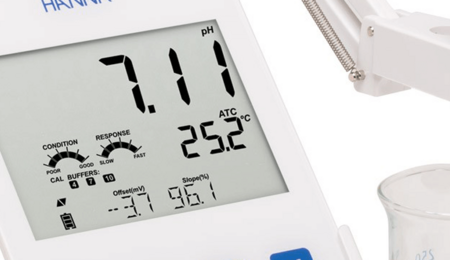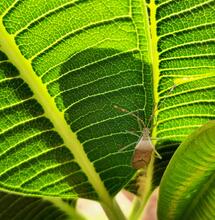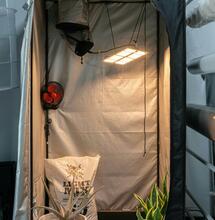pH & PPM Tailor To Your Crop

What’s pH? This is a question that usually makes new growers scratch their heads and reach for the pipe. pH applies to the level of alkalinity or acidity of a given “thing”, in this case a liquid. The liquid is the nutrient solution you’re using to grow your joy. The pH scale starts at 0 and rises to 14. A value of 7.0 is considered neutral, with values over 7.0 being alkaline and values below 7.0 being acidic. Now, you might be asking yourself why this is important. If you were a chemist, you’d know already. Since you’re not, here’s why.
By Thomas Valentine
The nutrient solution you’re using is basically a cocktail of various chemicals. These chemicals can react to each other in a process called covalent bonding and form new chemicals that you don’t want. You don’t want them because your plant can’t use them. This process of covalent bonding is largely dependent on the pH of the solution the chemicals are suspended in, in this case water. With the chemicals being used in your average hydroponic solution, a chemist would say that the optimum pH would be 7.0, which is neutral. The reasoning behind this is that in keeping the solution neutral, covalent bonding of the constituent parts of your solution will be kept to a minimum. But since your plants like a different pH level for optimum growth, you have to cater to your joy, lower the pH, and take the slight loss of nutrient value. Fast growing leafy plants generally like a lower pH in the range of 5.2 to 5.9. Fortunately, a lower pH will bond fewer nutrients of the type in your solution than will a higher pH. If you let the pH value go beyond the optimum range of 5.2 to 5.9, you’re opening yourself up to undesirable levels of nutritional deficiency and toxicity, both of which can seriously impede your growth. Be vigilant. In your research of the various hydroponic methods in use, you might have realized that most of the growing media in use is relatively inert (rockwool, pea gravel, sand, etc.). That is, the growing medium won’t react with the nutrients in the solution. For those methods that use inert media, a pH of 5.2 is recommended for optimal elemental uptake. It is at this pH level that the roots will assimilate the nutrients in your solution most efficiently. If the root has to work less to assimilate the required nutrients, the rest of the plant will benefit. At this point, those old-hand stoners that have been growing since the 60’s will shake their heads and tsk-tsk you. They will swear by a neutral pH of 7.0 for the nutrient solution (if they check the pH at all). New research has shown that this lower pH value is the optimum for green leafy plants that grow this quickly. My own experiments with this lower pH have convinced me – the buds were plentiful and fat, and the shake made couch-glue hash oil that was to die for.
Parts Per Million (PPM)
The tweaking of the concentration of the nutrient solution at various growth periods further enhances the nutrient assimilation rate. The concentration of a solution is measured in Parts Per Million (PPM). You wouldn’t normally have any nutrient solution feeding a newly cut clone, so the PPM of your solution at this stage isn’t an issue. Young, established seedlings or rooted clones however, are generally started at 500 to 600 PPM. This value is increased to 800 to 900 PPM during the peak foliage growth period. During the flowering period, the PPM is raised even higher to 1000 PPM. That’s a lot of nutrient, and it’s needed, every drop. It is at the flowering time that your plant will need the most resources. After the flowers have grown to buds, you’ll have to think about flushing the chemicals from your new creation. At this time, the plant still needs nutrients, but at a lower concentration. It is recommended then to reduce the concentration to 400 to 500 PPM for a couple of days to leach out the nutrients that have built up – you don’t want to end up smoking them. It is at this point that some people like to starve their plant to stimulate the survival response of generating more natural oils within the plant that will combat dehydration. This controlled drought has been shown to increase the levels of oil in the plant, and thus the THC (the good stuff). This general description of the growing process gives you the knowledge for more advanced decisions about the pH and concentration (PPM) of your nutrient solution. A word however, has to be given in regards to temperature and light.
Temperature & Light
The optimum temperature for hydroponic solutions in general is said to be 24 degrees Celsius. It is at this temperature that most elements are assimilated easily and atmospHeric oxygen is most readily accepted into your nutrient solution. Some might make the point that increases in temperature increase the rate of photosynthesis, and this is true. You must, however, cater to the nutritional needs of your plant and avoid exceeding the maximum listed temperature of 25 degrees Celsius for your solution. Some of the fancier hydroponic setups have the root / solution area separated from the growing / foliage area. The growing / foliage area is kept warmer than the root / solution area, thus getting the best of both worlds. Stay tuned for a future article on that one; it’s a great read. As I mentioned earlier, covalent bonding is the bane of the hydroponic gardener. Avoid it at every corner. This is easier said than done is some situations, but you have to know what you’re up against. In every covalent bond that occurs, some energy is used. This energy is taken from the surroundings in the form of heat, chemical energy, or light. If you have to mix up large batches of nutrient solution at once or if you buy it premixed, keep your solution in the dark and above all, keep your solution cool. Keeping the solution cool and dark won’t give the chemicals the energy required to do what unstable chemicals want to do – form stable covalent bonds. The first chemical to pursue a covalent bond is usually iron. Iron is notoriously free to form bonds with just about anything that passes by. If you must add it to your nutrient solution with other trace chemicals, do it just before you deliver the solution to the plant. This is to give the roots a fighting chance with the other chemicals in the solution, including the iron itself.
Measuring pH & PPM
Measuring pH is relatively easy, and you have quite a few choices in terms of methods. The most inexpensive and low-tech method entails taking a sample from your solution. It is put into a clean vial you get with the pH kit. You test for the pH by putting a drop of the something-or-other liquid that came in the kit into the vial (NOT the solution). The something-or-other makes the nutrient solution turn color, usually shades of green or blue-green. This color is then compared to a color chart that comes with the kit. The closest color is the pH of the solution. The method I use is a dead on balls accurate method, and involves buying a relatively inexpensive pH meter. The meter tests the pH down to a tenth of a point, and has proven itself indispensable – a good buy. Another meter tests the PPM of the solution as a whole. There’s no way around this one, people. If you want to control the PPM of your nutrient solution, you have to buy the meter. If you’re only growing a one-shot crop or just a few at a time, get the cheaper meter or mix the nutrients per gram according to the labeled instructions. If you’re going full throttle and growing for all of your friends, spend a bit more and get the reliability that comes with a quality product.
Adjusting pH & PPM
So now you know what pH and PPM are and how covalent bonds are dependant upon them. Great. And what do you do with this newfound knowledge, you ask? Simple. You add acid to it. Knowing what to add and when is paramount to your success as a joy-joy grower. When the pH level is too high (alkaline), it can be lowered with saltpeter, sulfuric acid or phosphorous. When the pH value is too low, it can be raised with calcium carbonate, lime or, potash. Most fertilizers cause a pH change in the nutrient solution. Adding fertilizer to the nutrient solution almost always results in a more acidic pH. Adjust accordingly. The proper way to handle all of these chemicals is important. The first general rule is that you don’t do it when you’re stoned. Just don’t do it – the plants can miss a feeding if necessary. Another general rule is to use glass or plastic, never metal. The nutrients will react with the very free elements in the metal and mess up your nutrient ratios. Glass or plastic doesn’t have that problem, so get your butt to the kitchen section of the nearest department store first. Never add the acid to the vat of nutrient. Fill a small glass container with the nutrient to be balanced and add a few drops of the necessary chemical. Stir it in well and add small amounts at a time to the large vat of nutrient until the proper PH balance is achieved. That’s all there is to it. Now you’re in business. As time goes on, the amount of salts produced by the breakdown of fertilizers in the medium causes it to become increasingly acidic. Eventually, the concentration of these salts in the medium will stunt the plant and cause browning out of the foliage. Also, as the plant gets older its roots become less effective in bringing food to the leaves. To avoid the accumulation of these salts in your medium and to ensure that your plant is getting all of the food it needs, be sure to flush your system with clean, pH balanced water every couple of weeks. Do this in lieu of that cycle’s feeding. There’s always been a big debate over when to adjust your pH – before and after you add nutrients to the water, or just after. We talked to an expert, and she said to do both. The reasoning for doing both is that water is rarely dead on neutral. It’s either acidic or alkaline, depending on your region. Our chemist said that the way the professionals do it is to render the water neutral first (pH of 7.0). You would then add your nutrients to that chemically neutral solution and adjust to the desired range within 5.2 to 5.9 pH. Makes sense. So that’s a few words on pH, PPM and covalent bonds.



.png)